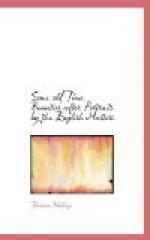The Lady Elizabeth Mary was born in 1797, and married, in 1819, Robert, Viscount Belgrave, eldest son of the second Earl of Grosvenor. The portrait by Sir Thomas Lawrence was painted in the year preceding her marriage.
The Marquisate of Westminster had been created in 1831, and in 1845, when the Viscount’s father died, he succeeded to the title. He had entered Parliament in 1818 as member for Chester. He spoke but rarely in the House, although a hard worker on committees. He greatly improved his vast London property, and had the credit of administering his estate with a combination of intelligence and generosity seldom seen. Of reserved habits and inexpensive tastes, he was averse to ostentation and extravagance. He died in 1869. His successor was his son (born in 1825) the present Duke, who was elevated to a dukedom in 1874. He is one of the wealthiest peers in the kingdom, is a man of great taste, and has patronized the arts with almost a Medician munificence.
The seat of the family is the renowned Eaton Hall, near Chester; that stately mansion set in the centre of a country rich in pastoral beauty. Its enlargement and beautification was begun by the second Earl in 1802, and has been carried on by its present lord until it is now the most magnificent of all the modern mansions of the nobility. G.F. Watts’s heroic equestrian statue of Hugh Lupus, the founder of the family and a nephew of William the Conqueror, challenges admiration as one enters the grounds. There is no great picture gallery in the Hall, for that is at Grosvenor House in London, but the family portraits are here. Let into panels of the dining-room are portraits from the time of the first Earl, who was painted by Gainsborough. The Viscount Belgrave and his lady were painted by Pickersgill, in 1825,—this picture of the latter being much inferior to Lawrence’s,—while the present generation was painted almost wholly by Millais,—that of Constance, the Duke’s first wife, being especially fine. Leslie, in 1833, executed a group of the Grosvenor family.
Lawrence and Hoppner were to the regency what Reynolds, Gainsborough, and Romney were to the early days of the reign of George III., as painters of the patrician beauties. What a marvellous mass of records of fair women these five have left us!—Reynolds, supreme in style, painting the character as seen through the fair mask of the flesh; Gainsborough, superbly picturesque, and a faithful limner withal; Romney, impressively picturesque, too, a fine colorist, imaginative, and but now, a century later, coming into his proper meed of praise; Lawrence, elegant, charming,—a courtier indeed; Hoppner, through many years a close rival of Lawrence. To Hoppner we are indebted for the visible evidence of the beauty of many who had repute as fair women. There is that piquant Jane Elizabeth, Countess of Oxford, who greets us in the National Gallery. Then that dark-eyed and winsome Lady Kenyon, who was one of the reigning belles,




